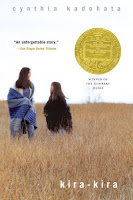Uplifting, Tender, Compassionate, Poignant, Admirable
Kira-Kira by Cynthia Kadohata
Published by Atheneum Books for Young Readers Copyright 2004
2005 Newbery Medal Award Winner
Katie Takeshima understands hardship. Growing up in the midst of the 1950s and 60s, racial tensions are still tight, especially when her Asian American family unexpectedly has to uproot from the cornfields of Iowa and relocate to Georgia. Her parents can barely make ends meet and must work long, hard days earning minimum wage to support their three children, Lynn, Katie, and Sammy. But, life does not get any easier when the Takeshima’s soon discover that Lynn has been diagnosed with lymphoma. Stricken by this disease, the family soon begins to crumble. It is Katie’s responsibility to remind her family that Lynn describes the world as Kira-Kira or glittering. In this eloquently written tale by Cynthia Kadohata, Katie finds the courage to keep her family together, to accomplish Lynn’s dreams and aspirations, and to remember that the world around her is glittering.
Reading Level: Lexile Framework 740, Grade 5
Suggested Delivery: Independent Read
Description: Historical Fiction, Diversity
Electronic Resources:
 Simon & Shuster
Simon & Shuster
This site gives students an overview of the text, background information about the author, pre-reading strategies, discussion questions, and activities to enhance comprehension after reading.
Video Summary
This is a brief video complete with illustrations and commentary that summarizes the plot. The video provides support for both visual and auditory learners.
Key Vocabulary: Anemia, Chronicle, Dormitory, Fatigue, Femininity, Hatchery, Hemoglobin, Incubator, Legendary, Union
Teaching Suggestions:
Pre-Reading- Introduce the reader to the text and explain that the title, Kira-Kira, means glittering. Have students write about something they believe represents Kira-Kira in a reader response log and support it with details.
During Reading- Katie, Lynn, and the rest of the Takeshima's encounter discrimination because of their Japanese background, their financial circumstances, and the kind of work the Takeshima's do. Have students make text-to-self connections in their reader response logs about a time when they felt they were discriminated against. Examples could include: race/ethnicity, gender, religion, socioeconomic status, etc.
Post-Reading- Using a Venn diagram, have students compare and contrast Katie at the beginning of the story to the end of the story, focusing on how she has changed.
Writing Activity: Have students write a Poem for Two Voices. Students can explore several different voices such as Katie and Lynn, Caucasian Americans and Japanese Americans, or businessmen like Mr. Takeshima's boss and poor workers. The focus of this poem is to compare and contrast the lives of these opposite figures.
Kadohata, C. (2004). Kira-kira. New York: Atheneum Books for Young Readers.
Reading Level: Lexile Framework 740, Grade 5
Suggested Delivery: Independent Read
Description: Historical Fiction, Diversity
Electronic Resources:
 Simon & Shuster
Simon & ShusterThis site gives students an overview of the text, background information about the author, pre-reading strategies, discussion questions, and activities to enhance comprehension after reading.
Video Summary
This is a brief video complete with illustrations and commentary that summarizes the plot. The video provides support for both visual and auditory learners.
Key Vocabulary: Anemia, Chronicle, Dormitory, Fatigue, Femininity, Hatchery, Hemoglobin, Incubator, Legendary, Union
Teaching Suggestions:
- Use this text in social studies to examine cultural diversity in the United States.
- Use this text in social studies to support a lesson on discrimination.
- Use this text in social studies to conduct a conversation about labor unions and worker's rights.
Pre-Reading- Introduce the reader to the text and explain that the title, Kira-Kira, means glittering. Have students write about something they believe represents Kira-Kira in a reader response log and support it with details.
During Reading- Katie, Lynn, and the rest of the Takeshima's encounter discrimination because of their Japanese background, their financial circumstances, and the kind of work the Takeshima's do. Have students make text-to-self connections in their reader response logs about a time when they felt they were discriminated against. Examples could include: race/ethnicity, gender, religion, socioeconomic status, etc.
Post-Reading- Using a Venn diagram, have students compare and contrast Katie at the beginning of the story to the end of the story, focusing on how she has changed.
Writing Activity: Have students write a Poem for Two Voices. Students can explore several different voices such as Katie and Lynn, Caucasian Americans and Japanese Americans, or businessmen like Mr. Takeshima's boss and poor workers. The focus of this poem is to compare and contrast the lives of these opposite figures.
Kadohata, C. (2004). Kira-kira. New York: Atheneum Books for Young Readers.




